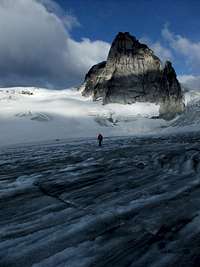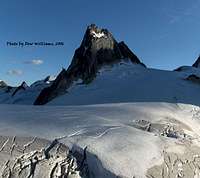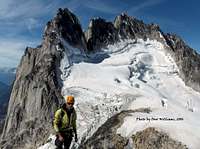-
 43460 Hits
43460 Hits
-
 96.25% Score
96.25% Score
-
 58 Votes
58 Votes
|
|
Mountain/Rock |
|---|---|
|
|
50.73194°N / 116.79111°W |
|
|
Mountaineering, Trad Climbing |
|
|
Summer |
|
|
10354 ft / 3156 m |
|
|
Overview/Route(s)
Pigeon Spire is located in Bugaboo Provincial Park, (33,700+ acres) home of several legendary granite spires. Bugaboo (Glacier) Provincial Park is part of the Bugaboo Alpine Provincial Recreation Area located in the Purcell Mountain Range of British Columbia. The Purcells parallel the Canadian Rockies on the western side. Pigeon Spire divides the Bugaboo and Vowell Glaciers guarding the approach to the famed Howser Towers. It is one of three that make up the “Central Spires” (Pigeon, Bugaboo and Snowpatch), the most common objectives in the park. T
he central spires each stand isolated by large glaciers with no connecting ridges. This stark contrast of black rock against white snow and ice is what contributes to this park being a climber-photographer’s dream. Pigeon Spire could easily be considered the most aesthetic of the Bugaboo Spires. From any angle, it appears to show off its black sharp walls as they contrast the glacier terrain. Yet its summit is one of the most accessible climbs in the Bugaboos by way of the classic and most popular West Ridge route. What can make it a much more appealing route is the optional, but rarely traveled, Pigeon Fork-Bugaboo Glacier approach traversing its much steeper east and south faces. Droves of climbers/visitors prefer to use the Snowpatch-Bugaboo col approach to avoid the more technical glacier travel.
While the West Ridge can resemble a human highway in peak season, Pigeon offers up many obscure and rarely climbed routes. The following routes are featured in “The Bugaboos, One of the World’s Great Alpine Rock-climbing Centres”, an exceptional guidebook in my opinion put out by Marc Piche and Chris Atkinson:
West Ridge- 5.4/500m- I soloed this route and have to admit that despite its easy rating, it is a must do for any level of climber. It is obviously considered the classic on the mountain and gives up dramatic views of the much more difficult Howser Towers. It is given three stars (maximum) by the guidebook. Exceptional rock with the crux at the end, that can either be down climbed or taken in two short rappels. Dow
Tail Feather Pinnacle Right-5.10a/4 Pitches
Tail Feather Pinnacle Left-5.10a/5 Pitches
Feather Fall Out-5.7 A2/6 Pitches
Northwest Face-5.7 A3/6 Pitches
Wingtip Arete-5.10a/8 Pitches
North Face-5.7/ A2/8 Pitches
Millar Shepard-5.6/8 Pitches
Pigeon Toe-Lower 5th/3 Pitches
Cooper-Kor-5.10/18 Pitches- Although the guide book mentions 18 pitches in total, we did it in no more than 14 total pitches with double 60m ropes. Getting over the bergschrund and moat could no doubt be problematic in the coming years. We had to pitch out one rope length on the glacier above the bergschrund but I personally would have been comfortable soloing it to the wall in 2009. The first two pitches involve stellar granite cracks. Eventually a long ledge walk, left to right, puts you below a long easy chimney section with a splitter crack variation out left. Up either one of these options lands you at the infamous slab traverse, left to right, with one piton (2009) protecting the whole distance! The ground is steep and slab features few. Obviously the 2nd will have to be as comfortable with slab skills as the leader on this pitch. At this point, following the guide book beta is a bit difficult and it could have been written more simply. This is where the aid or higher grade climbing enter the picture. Climb up a corner to its top, then tension down and right into another corner. Climb to this corner’s top, then delicately climb or tension the slab out right once again into yet a third corner. Follow grooves in the face along this corner until you can escape through a steep right wall hemmed in by two corners. This wall can be a nasty muddy mess making it quite the heady lead and crux of the day (as it was for us). The final pitch is a nice full on 60m pitch, right to left diagonal over vertical cracks to the upper right (northeast) shoulder of Pigeon Spire. Either solo or rope up a few more times ascending to the summit. Descend the west ridge which we did solo after the first two raps. Dow
Cleopatra’s Alley-5.10/ A2/13 Pitches
Southeast Buttress- 5.8/ A2/11 Pitches
Southeast Slabs- 5.6/ 11 Pitches
South Face- 5.6/ A1/10 Pitches
Mechanized bolting is not allowed in the park, therefore, this is specifically a trad climbing area. The glaciers in Bugaboo Provincial Park are retreating as most in Canada are. The Bugaboo Glacier itself has receded over 3000’ in the past 100 years. The wildlife is still exceptional. We spotted a black bear on the road in and wolverine tracks on the Pigeon Fork-Bugaboo Glacier. The weather is more volatile than even the Canadian Rockies due to the park’s closer proximity to the Pacific Ocean. Rock fall and weather remain the two most dangerous objectionable hazards for any climbing objective in the area.
Getting There
Bugaboo Provincial Park is located in southeastern B.C., between Golden and Radium Hot Springs, and west of Highway 95. Access to the park is via a gravel logging road, open late spring through late fall, that begins at Brisco, 27 kilometers north of Radium Hot Springs or 76 km south of Golden on Highway 95. You must travel 46 kilometers on the dirt road to get back to the trailhead. Watch for the small directional signs at intersections.
The trail to the Conrad Kain Hut is approximately 2260’ of gain spread out over 4.6kms and the Applebee campground is another 820’ of gain from the hut spread out over 1 km. We made the hut in less than 2 hours; some parties took 3.5 hours during our visit.
Access to the northern portions of the park via the Vowell and Malloy Creek drainages is possible by leaving Highway 95 at Spillimacheen, north of Brisco, then crossing the Columbia River and turning left on the West Side Road. After traveling 0.8 km, turn right onto Bobbie Burns Creek drainage and drive past the lodge of the same name. Logging roads up Vowell Creek and Malloy Creek lead to semi-open terrain which can be hiked into the park. The status of bridges in inactive logging areas may vary in upper drainages.
Red Tape
•Bugaboo Provincial Park is a remote area. Persons intending to visit the Bugaboos must realize there are no supplies, equipment or transportation arrangements of any kind available in the park. Hut accommodation is not available in winter because of avalanche dangers.
•It is recommended that visitors protect their vehicle perimeter with a portable chicken wire fence to deter porcupines and other small animals from chewing on wires and tires.
•National Topographic Series Maps 82K/10 (Howser Creek) and 82K/15 (Bugaboo Creek) are at a scale of 1:50,000 and cover all but the western limits of the park.
•'The Bugaboos - One of the World's Great Alpine Rock-climbing Centres' is a comprehensive and accurate guidebook to climbing and mountaineering in Bugaboo Park. It is written by Chris Atkinson and Marc Piche and published by Elaho Publishing (ISBN # 0-9733035-1-4).
•Weather conditions can change suddenly in this area and lightning storms with hail and snow are common in summer. Only experienced climbers practiced in crevasse rescue and properly roped should venture onto snowfields and glaciers.
•Loaded logging trucks and other industrial traffic may be encountered while accessing this park. Drive with extreme caution and for your safety always yield to industrial traffic.
Climbers should check with the hut keepers on current conditions and destinations before departure. Climbers are responsible for their own safety; rescue services are not readily available. Public communications services are not available.
When to Climb
Although CMH offers winter heli-skiing for tourists, Bugaboo Provincial Park is primarily a summer destination for climbers. Despite the necessary glacier travel, the quality of the rock is what most come to Bugaboo for therefore the summer months are prime. Late August was when I climbed in the region for the first time and it was stellar conditions. However, Bugaboo Provincial Park is well known for its volatile weather swings and for the most part, your views from the west are obscured.
Camping
Wilderness, backcountry or walk-in camping is allowed. Backcountry campgrounds are provided at Boulder Camp below the Conrad Kain Hut and on the bare rock slabs of Applebee Dome, 1km above the Conrad Kain Hut. A per-person fee is in effect at these campgrounds, payable at a self-registration station located inside the Conrad Kain Hut. To prevent contamination of the water supply and damage to the sensitive alpine environment, camping in the park is not permitted elsewhere in the vicinity of the main spires (Bugaboo, Snowpatch, Crescent, Pigeon, Howsers). Bivouacking is not permitted unless circumstances dictate its necessity. Wilderness camping is allowed in other, more remote areas of the park, such as the Vowell Group. Leave-no-trace wilderness camping ethics should be utilized.
Backcountry Camping Fee: $5.00 per person / night, for all persons 13 years of age or older.
There are hot and cold water taps in the Kain Hut. There are two pit toilets located near the Kain Hut for users of the Hut and Boulder Camp. There is also one pit toilet located at the Applebee campground and in the parking lot at the trailhead.
The Conrad Kain hut is a class “A” (pads, fuel, pots and dishes, running water) hut that sleeps 40. Reservations for the hut can be made through the ACC National Office from 9:00am to 8:00pm, seven days per week. The campgrounds operate on a "first come, first served" basis.
An on-site custodian collects fees for the campgrounds and hut (for those who did not reserve through the ACC office in Canmore) from mid June to late September. Tent sites and hut bedding must be cleared by 11:00am if you are not planning on staying that night.
Open fires and dogs are prohibited in the park. Ski tourers can book the hut from approximately mid March to May.
Climbing Sequence (Glacier) West Ridge
Climbing Sequence (Rock) West Ridge
Mountain Conditions
The Ministry of the Environment of BC has weather, wildlife reports, trail closures, etc. Outside of the parks web site, Canadian Avalanche Association is also useful, particularly for winter travel. Canadian Alpine Accident Reports are also extremely useful.



















